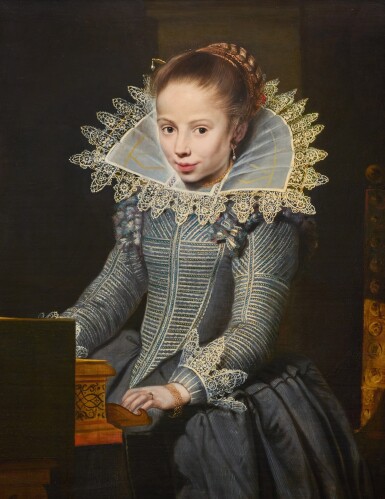
Property from the Hans and Marion König Collection
Cornelis de Vos
Portrait of a Young Girl at the Virginals
Auction Closed
February 6, 04:38 PM GMT
Estimate
600,000 - 800,000 USD
Lot Details
Description
Property from the Hans and Marion König Collection
Cornelis de Vos
Hulst circa 1584 - 1651 Antwerp
Portrait of a Young Girl at the Virginals
oil on panel
panel: 32 by 23 ¼ in.; 81.0 by 61.5 cm
framed: 40 by 33 in.; 101.8 by 83.6 cm
With Thomas Agnew & Sons Ltd., London;
Daniel H. Farr, Philadelphia, by 1920;
Mrs. Edward Bok (née Mary Louise Curtis; 1876-1970), Philadelphia, by 1939;
Thence by descent to her son, Cary W. Bok (1905-1970);
By whose estate sold, New York, Christie's, 11 January 1979, lot 42;
With Richard Green, London, 1979;
From whom acquired by Hans and Marion König, 1985.
Haarlem, Frans Hals Museum; Antwerp, Koninklijk Museum voor Schone Kunsten, Pride and Joy, Children's Portraits in the Netherlands, 7 October 2000 - 23 April 2001, no. 23.
E. Greindl, "Les Portraits de Corneille de Vos," in Annuaire des Musees Royaux des Beaux-Arts de Belgique 2 (1939), p. 162, reproduced fig. 20;
E. Greindl, Corneille de Vos, portraitiste flamand, Brussels 1944, pp. 67, 153;
K. Van der Stighelen, De Portretten van Cornelis De Vos: Een Kritische Catalogus, Brussels 1990, pp. 74-77, cat. no. 30, reproduced;
K. Van der Stighelen, in Pride and Joy, Children's Portraits in the Netherlands, exhibition catalogue, J.B. Bedaux and R. Ekkart (eds.), Amsterdam 2000, pp. 140-141, cat. no. 23.
In early seventeenth-century Antwerp—where the artistic milieu included luminaries such as Anthony van Dyck and Peter Paul Rubens—Cornelis de Vos emerged as the leading painter of children’s portraits for the city’s prosperous bourgeoisie. Painted circa 1625–1630, this portrait of a young girl is distinguished as "one of the master’s most original compositions,"1 encapsulating the Flemish painter’s inventive powers and technical prowess.
De Vos was notably the only South Netherlandish master to specialize in the portrayal of children. While he absorbed a range of artistic skills through collaborations with the most innovative artists of the day, including Rubens, Van Dyck, and Jacob Jordaens, his personal style was distinguished by the luminescence of painted flesh and bright tactility of highlights. De Vos's clientele were primarily Antwerp's bourgeoisie families rather than the aristocracy. Consequently, he faced fewer pressures to elevate his subjects through grandiose gestures and courtly graces. Instead, his sitters often possess a sense of amiable, quiet confidence, while their material prosperity and social rank is reflected in their lavish costumes and accessories.
From the tenderness of the sitter’s expression to the meticulously rendered textures of her costume and jewelry, every element of this exceptional portrait reflects De Vos's masterful touch and distinctive approach. He depicts the young woman, radiantly illuminated against a dark background, with a candid sensibility and closely observed physiognomic expression. The sitter, though unidentified, is undoubtedly a child of considerable means. Her light brown hair is twisted into a chignon fastened with a pearl hairpin, and matching pearl pendants dangle from her ears.2 She is further adorned with a gold chain around her neck and a bracelet on her left wrist. Rendered by De Vos using an abundance of expensive blue pigment, her lavish dress and monumental lace collar supported by a portefraes were the height of fashion during the late 1620s.
Her elegant, attenuated hands delicately poised on the keyboard, the girl is seated before a virginal, an instrument that may function as both a status symbol and a linguistic allusion to her chastity. Furthermore, her pose recalls contemporary depictions of the virgin martyr Saint Cecilia, often depicted playing a keyboard instrument, reinforcing the sitter’s association with purity and other saintly characteristics. The virginals itself, like the more commonly depicted portrait attributes of handkerchiefs, letters, or gloves, signifies her family’s wealth and refinement to a contemporary viewer.
A unique and inventive aspect of this composition, the position of the virginals, which seems to extend beyond the boundary of the canvas and into the viewer's own space, creates a sense of continuity between the fictive realm of the painting and that of the spectator. It is almost as if the young musician seeks to implore the undivided attention of her audience, whose presence she acknowledges with a direct and reciprocal gaze, in anticipation of the melodic tune she is preparing to play.
1 Quoted from E. Greindl 1944, p. 153: "L'une des compositions les plus originales du maître."
2 In the seveneenth century, pearls were primarily a sign of wealth, however in some contexts, they also possessed religious or moral connotations as symbolis of purity and chastity.
You May Also Like










